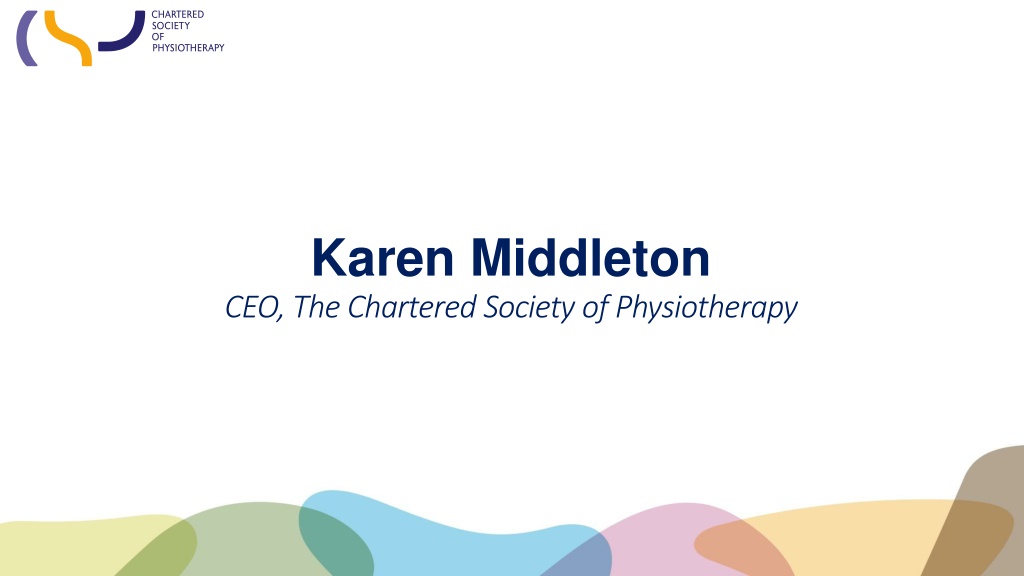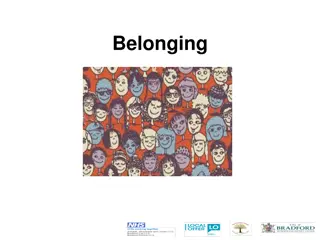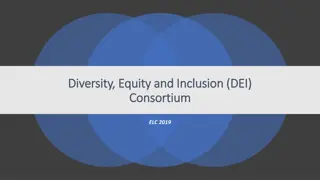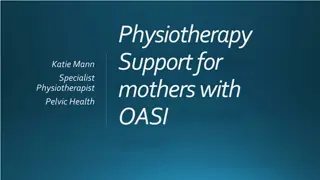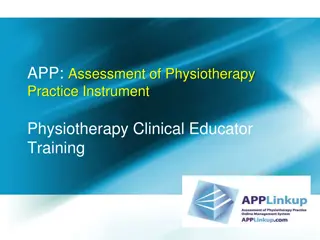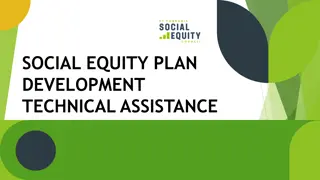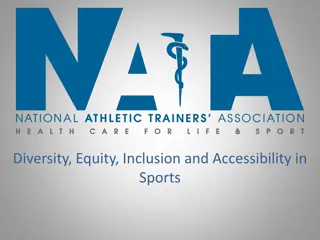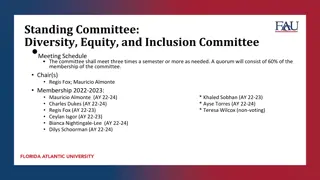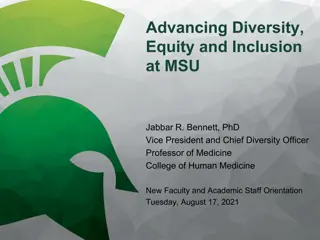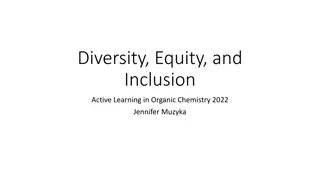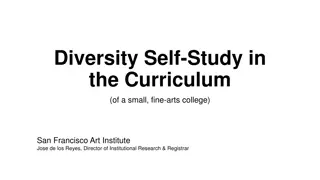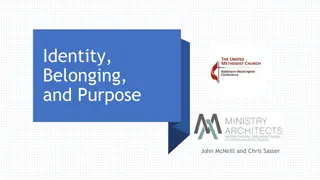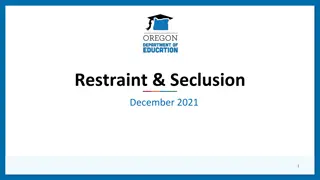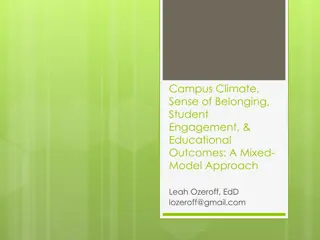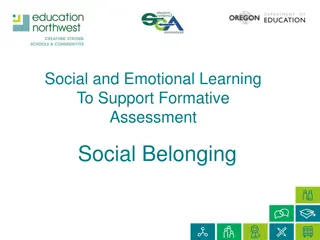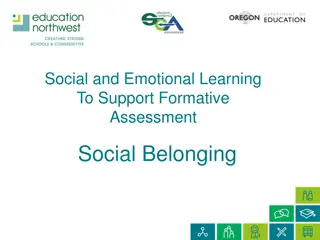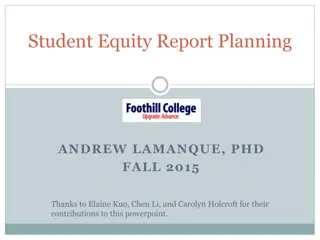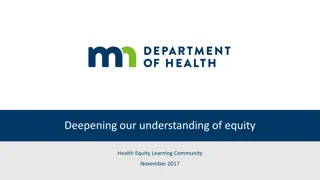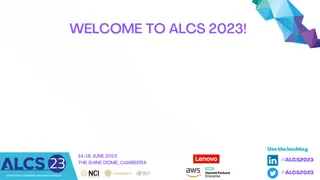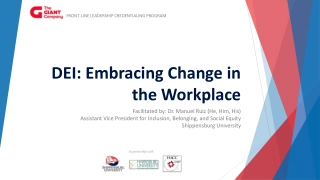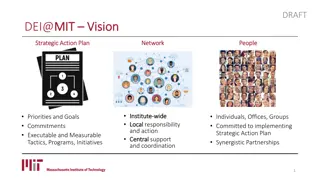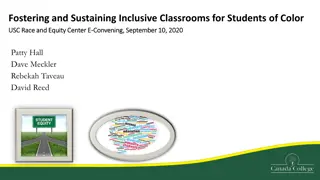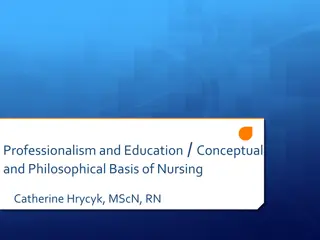Importance of Equity, Diversity, and Belonging in Physiotherapy Profession
Equity, diversity, and belonging are crucial in the physiotherapy profession to oppose discrimination, support fair treatment, ensure equal access for patients, and set an example of inclusive practices. Awareness of outsider status, challenges in addressing racism, and strategies for success are also highlighted. The strategic aims for 2023-2027 focus on improving community health, empowering members, building a confident physiotherapy community, and creating a sustainable organization.
Uploaded on Sep 28, 2024 | 0 Views
Download Presentation

Please find below an Image/Link to download the presentation.
The content on the website is provided AS IS for your information and personal use only. It may not be sold, licensed, or shared on other websites without obtaining consent from the author. Download presentation by click this link. If you encounter any issues during the download, it is possible that the publisher has removed the file from their server.
E N D
Presentation Transcript
Karen Middleton CEO, The Chartered Society of Physiotherapy
Why is equity, diversity and belonging so important to the profession? As a trade union and professional body working in healthcare, it is fundamental to our work that we: Oppose racism, xenophobia, sexism, homophobia, biphobia, transphobia, anti- Semitism, Islamophobia, ageism, classism and hatred against people with disabilities Support members facing unfair treatment at work, in education or other aspects of their lives Seek equal access, treatment and outcomes for all patients Ensure strategic decisions are informed by the full diversity of our members Set an example of good practice in equality, diversity and inclusion as an employer
Consciousness of being an outsider Profession defined by white normative views General conversations also white middle class Ideal character subject to cultural stereotypes Feeling other the outsider Awkward use of terminology Dismissive of presence of racism Lack of appropriate acknowledgement / management of racism in practice Micro-aggressions Be prepared to excel Regulate behaviours Avoiding conflict Absence of role models Adapting reflective tools Emotional labour Experience People s responses amplifying difference Personal strategies and burden Hammond et al 2019
Strategic Aims 2023-2027 A. Improve the health of communities through high quality physiotherapy B. Enable members to achieve their full potential at work or when learning C. Establish a confident and influential physiotherapy community D. Create an agile and sustainable organisation, able to pre-empt changing member needs 5
A: Improve the health of communities through high quality physiotherapy A1: Lead the transformation of physiotherapy by harnessing evidence based best practice to address health inequities and meet population health needs (EDB) A2: Promote physiotherapy staffing levels that meet service needs and reflect society across all sectors (EDB) A3: Promote equity for patients (EDB) A4: Integrate access to physiotherapy into primary care B: Enabling members to achieve their full potential B1: Improve member experiences of education, seeking work and work (EDB) B2: Champion fair pay, terms and conditions for physios and physio support workers in all sectors and locations B3: Support chartered and associate members to fulfil their career potential (EDB) D: Create an agile and sustainable organisation, able to pre-empt changing member needs D1: Achieve long term financial sustainability D2: Enable our Council and committees to thrive (EDB) Enable our staff to thrive (EDB) D3: Reduce the environmental impact of CSP operations D4: Enhance member benefit through developing and delivering a strategy to transform our use of data and digital systems C: Build a confident and influential physiotherapy community C1: Through the CSP provide physios, physio students and physio support workers with a supportive community (EDB) C2: Lead the movement for rehabilitation C3: Create a collaborative community of rehabilitation and exercise professionals. C4: Enable members to promote physiotherapy as a sustainable healthcare intervention
Strategic Aim A2 Promote physiotherapy staffing levels that meet service needs and reflect society Where are we now? Where might we be going? What are we doing?
Strategic Aim A2: Promote physiotherapy staffing levels that meet service needs and reflect society Where are we now?
Strategic Aim A2: Promote physiotherapy staffing levels that meet service needs and reflect society Where are we now?
Strategic Aim A2: Promote physiotherapy staffing levels that meet service needs and reflect society Where are we now?
Strategic Aim A2: Promote physiotherapy staffing levels that meet service needs and reflect society Where might we be going? Gender: Applicants vs 1st Year Intake 60.0% 50.0% 40.0% 30.0% 20.0% 10.0% 0.0% Cis Male Cis female Transgender Male Transgender Female Non-binary Other Not known Preferred not to say Applicants Year 1 intake
Strategic Aim A2: Promote physiotherapy staffing levels that meet service needs and reflect society Where might we be going? Age: Applicants vs Year 1 intake for 2020/21 60.00% 50.00% 40.00% 30.00% 20.00% 10.00% 0.00% Under 17 17-20 21-24 25-29 30-34 35-39 40-44 45-49 50+ Unknown Applicants Year 1 intake
Strategic Aim A2: Promote physiotherapy staffing levels that meet service needs and reflect society Where might we be going? Ethnicity breakdown for Year 1 UK domicile students - 2020/21 White Not known/Information refused Irish Traveller 0.44%0.60% Black or Black British - Caribbean 1.77% 1.71% Black or Black British - African 0.89% 2.19% Other Black background 0.44% Asian or Asian British - Indian Asian or Asian British - Pakistani 0.92% Asian or Asian British - Bangladeshi 17.62% 1.05% Chinese 2.76% 80.60% Other Asian background 0.44% Mixed - White and Black Caribbean 0.48% Mixed - White and Black African 1.49% 0.06% 0.38% Mixed - White and Asian Other Mixed background 3.77% Arab Other Ethnic background
Strategic Aim A2: Promote physiotherapy staffing levels that meet service needs and reflect society Where might we be going? UK physio graduates 2020/2021 2011 census 86% 84.02% White 14% 13.99% Black, Asian, Minority Ethnic 8% 5.18% Asian 3% 3.75% Black inc. in Asian above 1.19% Chinese 2% 3.19% Mixed 1% 0.68% Other 0 Prefer not to say 0 1.99% Unknown
Strategic Aim A2: Promote physiotherapy staffing levels that meet service needs and reflect society Where might we be going? Percentage breakdown of first year students with a disability for 2020/21 0.61% 1.41% 2.02% 5.45% 2.83% 5.25% 9.70% 17.17% 55.56% Social/communication impairment Visual impairment Hearing impairment Long standing condition Mental Health Condition Learning Difficulty Physical impairment Other Two or more impairments
Strategic Aim A2: Promote physiotherapy staffing levels that meet service needs and reflect society Where might we be going? Breakdown of first year learners disclosing a disability 2013/14 - 2020/21 70.00% 60.00% 50.00% 40.00% 30.00% 20.00% 10.00% 0.00% Social/communication impairment Visual impairment Hearing impairment Long standing condition Mental health condition Learning difficulty Physical impairment Other Two or more impairments 2013/14 2014/15 2015/16 2016/17 2017/18 2018/19 2019/20 2020/21
Strategic Aim A2: Promote physiotherapy staffing levels that meet service needs and reflect society What are we doing? Progress: Future: Ensuring no gaps in datasets Interrogation of the data Work with HEE on overseas qualified physios Policy and influencing Supporting members in the workforce including support worker development Increase representation of members with protected characteristics amongst those leading and influencing the profession e.g. mentoring and leadership development Web resources to encourage people to feel that physiotherapy is a career for them Career Development Framework Preceptorship Influence HEIs to ensure more representative intake and outflow of students Student Disability Guidance 2.0
